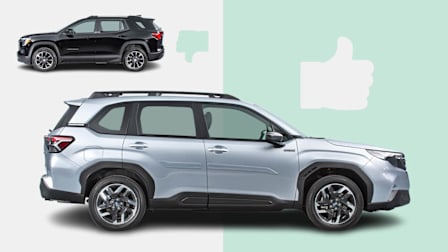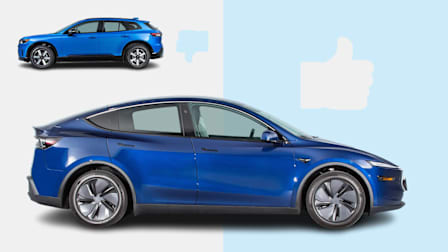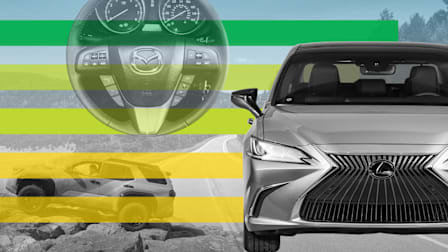What You Need to Know About Paddle Shifters
Those flaps found behind many steering wheels allow sporty drivers to enhance control and responsiveness
Only 4 percent of American drivers say that the vehicle they most often drive has a manual transmission, according to a May 2023 nationally representative CR survey (PDF) of 2,000 American adults. But many automatic cars today also have the ability to be driven like a manual—almost.
Have you noticed two flap- or ear-like appendages poking out from behind your steering wheel—one on either side? Maybe there’s a minus sign on the left one and a plus sign on the right one. Those are paddle shifters, which allow you to manually select gears on an automatic transmission-equipped car for more control or responsiveness.
Formula 1 drivers have been using paddle shifters since the ’90s. “Instead of having a stick on the side where you have to take your hands off the wheel to shift, you can keep your hands on the wheel,” says Mario Andretti, who captured the checkered flag in everything from Formula 1 to NASCAR over his decades-long racing career. “For a professional race driver, it makes everything faster and easier.” Andretti says that, all other things being equal, a car with paddle shifters will always beat one that has an old-fashioned stick shifter.
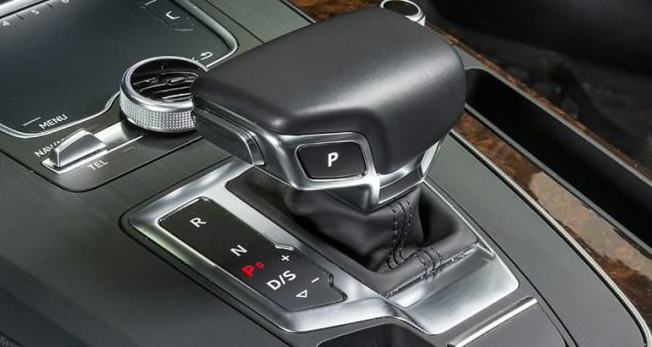
Photo: John Powers/Consumer Reports Photo: John Powers/Consumer Reports
How Paddle Shifters Work
How do you activate the paddle shifters? With the gear selector in Drive, squeeze the paddle toward you with your fingertips for either a downshift or an upshift. On most cars, the paddles are always active. In some cars, the shifter has to be slid into manual mode first, or there will be a button. (If you’re not sure, that information can be found in the owner’s manual.) Most systems will automatically return to regular automatic mode if the driver hasn’t pulled a paddle in 5 to 10 seconds. Holding down the “+” paddle for a few seconds usually switches back to auto mode as well. (Consult the owner’s manual to find out.)
How do you operate the paddles? Grip the steering wheel so that your palms contact the rim of the wheel, in the 9 and 3 o’clock positions, and your fingertips touch the backs of the paddles. Most paddle shifters will move with the steering wheel, so you can shift without ever moving your hands. Typically, the right paddle shifts to the next highest gear and the left paddle selects the next gear ratio down.
When should you shift? For performance, you can rev the engine higher by keeping it in a lower gear longer when you want faster acceleration. Shift up to the next gear whenever engine rpms start to get high, or when you feel like you’ve gained the power boost you wanted and you’re ready to cruise at a lower rpm. Typically, cars with paddle shifters will have a tachometer with a clearly marked red line, plus a rev limiter will prevent over-revving.
Can you slow the car with the paddles? Downshift to the next lowest gear to help slow the car when braking. The engine will turn at a higher rpm, which will cause resistance upon deceleration and slow the wheels. You can slow the car this way in a straight line (always giving yourself enough space to stop the car using the brakes if you have to), or just before entering a turn. Be aware that downshifting into turns is for experienced performance drivers only. If you shed too many gears into a turn, and the wheels are turning slower than the car is moving, you could potentially lose traction and spin the car.
What if you want to save fuel? Use the transmission’s automatic mode. Paddle shifters, while great for performance, tend to take the engine out of its most fuel-efficient operating range. Holding the car at higher rpms longer lets you tap into the engine’s peak power band for increased performance but will also burn more fuel. In automatic mode, the car’s computer knows when to shift gears in a way that will achieve the best balance of performance and efficiency. If your car is equipped with selectable driving modes, you may have noticed that the economy mode tends to keep the engine at lower rpms much of the time, providing relaxed cruising and optimal fuel economy.

















